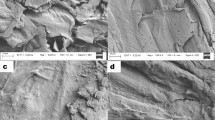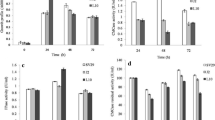Abstract
Sugarcane tops (SCT) may be an imperative lignocellulosic feedstock for production of renewable energy in view of ever-rising global energy demands. The current study presents the first ever report of combinative pretreatment of sugarcane tops biomass using ionic liquid (1-ethyl-3-methylimidazolium chloride) and alkali (ammonium carbonate) for effective and enhanced saccharification. The enzymatic hydrolysis of combinatorially pretreated SCT biomass resulted in a significantly higher reducing sugar yield (172.34 mg/g biomass) as compared to that obtained after standalone IL (85.9 mg/g biomass) or alkali pretreatment (102.6 mg/g biomass). The saccharification enzymes (cellulase/xylanase) used for hydrolysis of pretreated SCT biomass were in-house produced from an IL-tolerant, newly isolated fungus Penicillium chrysogenum VS4. Optimization of process variables for combined pretreatment was accomplished based on design of experiments, and enhanced reducing sugar yield was obtained. The experimental design for ascertaining optimal level of process variables, i.e., biomass loading (5.33%, w/w), temperature (100 °C), and time (4.50 h) was validated. Optimization of the process parameters resulted in 25.27% increased reducing sugar yield (215.89 mg/g biomass) as compared to that under unoptimized process. Ultrastructural analysis of SCT biomass after combined pretreatment was investigated by scanning electron microscopy and Fourier transform infrared spectroscopy which indicated that the biomass had undergone drastic alterations and substantial disintegration due to pretreatment. The current study highlights the potential of combinative pretreatment strategy for efficient conversion of SCT biomass. Such combined pretreatment approaches may be extended to other biomass feedstocks as well for developing successful biorefineries.
Graphical abstract






Similar content being viewed by others
Data availability
All datasets used and analyzed in the current study are available from the corresponding author.
References
Xie W, Ren Y, Jiang F, Liang J, Du SK (2020) Pretreatment of quinoa straw with 1-butyl-3-methylimidazolium chloride and physiochemical characterization of biomass. Renew Energy 146:1364–1371. https://doi.org/10.1016/j.renene.2019.07.072
Nargotra P, Sharma V, Sharma S, Kapoor N, Bajaj BK (2020) Development of consolidated bioprocess for biofuel-ethanol production from ultrasound-assisted deep eutectic solvent pretreated Parthenium hysterophorus biomass. Biomass Convers Biorefin 1-16. https://doi.org/10.1007/s13399-020-01017-0
Saini JK, Gupta R, Verma A, Gaur P, Saini R, Shukla R, Kuhad RC (2019) Integrated lignocellulosic biorefinery for sustainable bio-based economy. In: Sustainable approaches for biofuels production technologies. Springer, Cham, pp 25–46. https://doi.org/10.1007/978-3-319-94797-6_2
Olugbade TO, Ojo OT (2020) Biomass torrefaction for the production of high-grade solid biofuels: a review. Bioenergy Res 13:1–17. https://doi.org/10.1007/s12155-020-10138-3
Carrillo-Nieves D, Alanis MJR, de la Cruz QR, Ruiz HA, Iqbal HM, Parra-Saldivar R (2019) Current status and future trends of bioethanol production from agro-industrial wastes in Mexico. Renew Sustain Energy Rev 102:63–74. https://doi.org/10.1016/j.rser.2018.11.031
Sharma V, Nargotra P, Bajaj BK (2019) Ultrasound and surfactant assisted ionic liquid pretreatment of sugarcane bagasse for enhancing saccharification using enzymes from an ionic liquid tolerant Aspergillus assiutensis VS34. Bioresour Technol 285:121319. https://doi.org/10.1016/j.biortech.2019.121319
Trinh LTP, Lee YJ, Lee JW, Lee WH (2018) Optimization of ionic liquid pretreatment of mixed softwood by response surface methodology and reutilization of ionic liquid from hydrolysate. Biotechnol Bioprocess Eng 23:228–237. https://doi.org/10.1007/s12257-017-0209-x
Alayoubi R, Mehmood N, Husson E, Kouzayha A, Tabcheh M, Chaveriat L, Gosselin I (2020) Low temperature ionic liquid pretreatment of lignocellulosic biomass to enhance bioethanol yield. Renew Energy 145:1808–1816. https://doi.org/10.1016/j.renene.2019.07.091
Vaid S, Bhat N, Nargotra P, Bajaj BK (2018) Combinatorial application of ammonium carbonate and sulphuric acid pretreatment to achieve enhanced sugar yield from pine needle biomass for potential biofuel–ethanol production. Energy Ecol Environ 3:126–135. https://doi.org/10.1007/s40974-018-0083-1
Nargotra P, Sharma V, Gupta M, Kour S, Bajaj BK (2018) Application of ionic liquid and alkali pretreatment for enhancing saccharification of sunflower stalk biomass for potential biofuel-ethanol production. Bioresour Technol 267:560–568. https://doi.org/10.1016/j.biortech.2018.07.070
Kassaye S, Pant KK, Jain S (2017) Hydrolysis of cellulosic bamboo biomass into reducing sugars via a combined alkaline solution and ionic liquid pretreatment steps. Renew Energy 104:177–184. https://doi.org/10.1016/j.renene.2016.12.033
Liu Z, Li L, Liu C, Xu A (2018) Pretreatment of corn straw using the alkaline solution of ionic liquids. Bioresour Technol 260:417–420. https://doi.org/10.1016/j.biortech.2018.03.117
Kim JS, Lee YY, Kim TH (2016) A review on alkaline pretreatment technology for bioconversion of lignocellulosic biomass. Bioresour Technol 199:42–48. https://doi.org/10.1016/j.biortech.2015.08.085
Zhao C, Shao Q, Chundawat SP (2019) Recent advances on ammonia-based pretreatments of lignocellulosic biomass. Bioresour Technol 298:122446. https://doi.org/10.1016/j.biortech.2019.122446
Niju S, Nishanthini T, Balajii M (2020) Alkaline hydrogen peroxide-pretreated sugarcane tops for bioethanol production-a process optimization study. Biomass. Convers Bior 10:149–165. https://doi.org/10.1007/s13399-019-00524-z
Raghavi S, Sindhu R, Binod P, Gnansounou E, Pandey A (2016) Development of a novel sequential pretreatment strategy for the production of bioethanol from sugarcane trash. Bioresour Technol 199:202–210. https://doi.org/10.1016/j.biortech.2015.08.062
Pathak P, Gupta A, Bhardwaj NK, Goyal A, Moholkar VS (2020) Impact of mild and harsh conditions of formic acid-based organosolv pretreatment on biomass fractionation of sugarcane tops. Biomass Convers Biorefin 1-14. https://doi.org/10.1007/s13399-020-00629-w
Amoah J, Ogura K, Schmetz Q, Kondo A, Ogino C (2019) Co-fermentation of xylose and glucose from ionic liquid pretreated sugar cane bagasse for bioethanol production using engineered xylose assimilating yeast. Biomass Bioenergy 128:105283. https://doi.org/10.1016/j.biombioe.2019.105283
Sindhu R, Kuttiraja M, Preeti VE, Vani S, Sukumaran RK, Binod P (2013) A novel surfactant-assisted ultrasound pretreatment of sugarcane tops for improved enzymatic release of sugars. Bioresour Technol 135:67–72. https://doi.org/10.1016/j.biortech.2012.09.050
Sluiter A, Hames B, Ruiz R, Scarlata C, Sluiter J, Templeton D, Crocker D (2008) Determination of structural carbohydrates and lignin in biomass. Technical Report-NREL/TP-510–42618 National Renewable Energy Laboratory, Golden
Miller GL (1959) Use of dinitrosalicylic acid reagent for determination of reducing sugar. Anal Chem 31:426–428
Sharma S, Sharma V, Nargotra P, Bajaj BK (2018) Process desired functional attributes of an endoxylanase of GH10 family from a new strain of Aspergillus terreus S9. Int J Biol Macromol 115:663–671. https://doi.org/10.1016/j.ijbiomac.2018.04.096
Nargotra P, Sharma V, Bajaj BK (2019) Consolidated bioprocessing of surfactant-assisted ionic liquid-pretreated Parthenium hysterophorus L. biomass for bioethanol production. Bioresour Technol 289:121611. https://doi.org/10.1016/j.biortech.2019.121611
Sherpa KC, Ghangrekar MM, Banerjee R (2018) A green and sustainable approach on statistical optimization of laccase mediated delignification of sugarcane tops for enhanced saccharification. J Environ Manage 217:700–709. https://doi.org/10.1016/j.jenvman.2018.04.008
Niju S, Swathika M, Balajii M (2020) Pretreatment of lignocellulosic sugarcane leaves and tops for bioethanol production. In: Lignocellulosic biomass to liquid biofuels 301–324. Academic Press. https://doi.org/10.1016/B978-0-12-815936-1.00010-1
Vaid S, Bajaj BK (2017) Production of ionic liquid tolerant cellulase from Bacillus subtilis G2 using agroindustrial residues with application potential for saccharification of biomass under one pot consolidated bioprocess. Waste Biomass Valoriz 8:949–964. https://doi.org/10.1007/s12649-016-9626-x
Grewal J, Ahmad R, Khare SK (2017) Development of cellulase-nanoconjugates with enhanced ionic liquid and thermal stability for in situ lignocellulose saccharification. Bioresour Technol 242:236–243. https://doi.org/10.1016/j.biortech.2017.04.007
Prajapati BP, Suryawanshi RK, Agrawal S, Ghosh M, Kango N (2018) Characterization of cellulase from Aspergillus tubingensis NKBP-55 for generation of fermentable sugars from agricultural residues. Bioresour Technol 250:733–740. https://doi.org/10.1016/j.biortech.2017.11.099
Yegin S (2017) Single-step purification and characterization of an extreme halophilic, ethanol tolerant and acidophilic xylanase from Aureobasidium pullulans NRRL Y-2311-1 with application potential in the food industry. Food Chem 221:67–75. https://doi.org/10.1016/j.foodchem.2016.10.003
de Cassia PJ, Giese EC, de Souza Moretti MM, dos Santos Gomes AC, Perrone OM, Boscolo M, Martins DAB (2017) Effect of metal ions, chemical agents and organic compounds on lignocellulolytic enzymes activities. Enzyme Inhibit Activat:139–164
Hamid A, Aftab MN (2019) Cloning, purification, and characterization of recombinant thermostable β-xylanase Tnap_0700 from Thermotoga naphthophila. Appl Biochem Biotechnol 189(4):1274–1290. https://doi.org/10.1007/s12010-019-03068-0
Liang L, Li C, Xu F, He Q, Yan J, Luong T, Simmons BA, Pray TR, Singh S, Thompson VS, Sun N (2017) Conversion of cellulose rich municipal solid waste blends using ionic liquids: feedstock convertibility and process scale-up. RSC Adv 7:36585–36593 https://doi.org/10.1039/C7RA06701A
Reis CLB, e Silva LMA, Rodrigues THS, Felix AKN, de Santiago-Aguiar RS, Canuto KM, Rocha MVP (2017) Pretreatment of cashew apple bagasse using protic ionic liquids: enhanced enzymatic hydrolysis. Bioresour Technol 224:694–701. https://doi.org/10.1016/j.biortech.2016.11.019
Sun S, Sun S, Cao X, Sun R (2016) The role of pretreatment in improving the enzymatic hydrolysis of lignocellulosic materials. Bioresour Technol 199:49–58. https://doi.org/10.1016/j.biortech.2015.08.061
Hassan SS, Ravindran R, Jaiswal S, Tiwari BK, Williams GA, Jaiswal AK (2020) An evaluation of sonication pretreatment for enhancing saccharification of brewers’ spent grain. Waste Manage 105:240–247. https://doi.org/10.1016/j.wasman.2020.02.012
Acknowledgments
BKB acknowledges the following: Institute of Advanced Study, Durham University, UK, for providing COFUND International Senior Research Fellowship for research stay at Department of Biosciences, Durham University, Durham, UK., Commonwealth Scholarship Commission, UK, for providing Commonwealth Fellowship for research stay at Institute of Biological, Environmental and Rural Sciences (IBERS), Aberystwyth University, Aberystwyth, UK, and Indo-US Science and Technology Forum (IUSSTF) for research stay at Ohio State University, USA. Authors thank the Director, School of Biotechnology, University of Jammu, Jammu for necessary laboratory facilities, and SAIF, STIC, Cochin University of Science and Technology, Kerala, India, for physicochemical analysis of samples.
Funding
Financial support in the form of Research Projects to Dr. Bijender Kumar Bajaj (BKB) from funding agencies such as Department of Science and Technology (DST), University Grants commission (UGC), and Council of Scientific and Industrial Research (CSIR) is gratefully acknowledged. Mr. Vishal Sharma thankfully acknowledges Department of Science and Technology (Govt. of India) for providing Inspire fellowship for doctoral research. Ms. Parushi Nargotra acknowledges Rashtriya Uchchattar Shiksha Abhiyan (RUSA) for providing Ph.D. research fellowship. Ms. Surbhi Sharma is thankful to University of Jammu for providing University research scholarship.
Author information
Authors and Affiliations
Contributions
Dr. Bijender Kumar Bajaj (BKB) hypothesized and designed the research problem; Mr. Vishal Sharma (VS) and Ms. Parushi Nargotra (PN) designed and performed the experiments; PN, VS, and BKB analyzed and interpreted the data; Ms. Surbhi Sharma wrote the draft manuscript; BKB, PN, and VS corrected the MS; BKB submitted the MS. All authors read and approved the final manuscript.
Corresponding author
Ethics declarations
Ethics approval and consent to participate
Not applicable.
Consent for publication
All authors agree to publish this manuscript.
Competing interests
The authors declare that they have no competing interests.
Additional information
Publisher’s note
Springer Nature remains neutral with regard to jurisdictional claims in published maps and institutional affiliations.
Rights and permissions
About this article
Cite this article
Sharma, V., Nargotra, P., Sharma, S. et al. Efficient bioconversion of sugarcane tops biomass into biofuel-ethanol using an optimized alkali-ionic liquid pretreatment approach. Biomass Conv. Bioref. 13, 841–854 (2023). https://doi.org/10.1007/s13399-020-01123-z
Received:
Revised:
Accepted:
Published:
Issue Date:
DOI: https://doi.org/10.1007/s13399-020-01123-z




